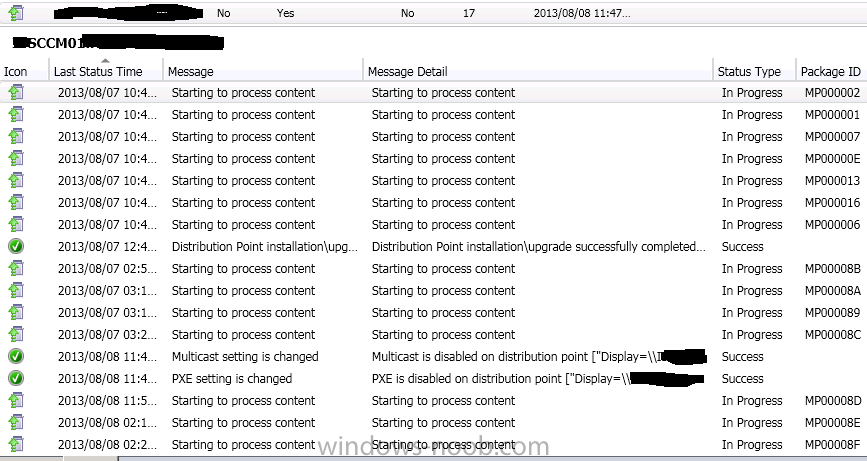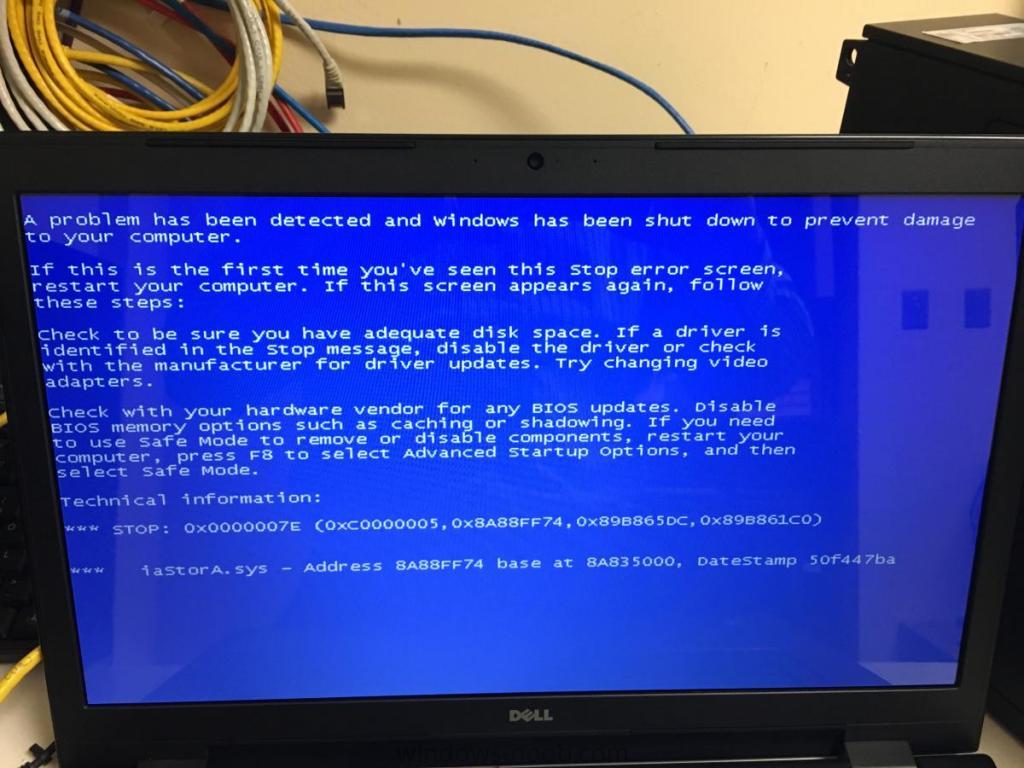Search the Community
Showing results for tags 'SCCM 2012'.
-
Hi there. I currently have 1 SCCM 2012 server that we use to deploy images via PXE boot, to MS Surface Books. This is at our main headquarter sites. We have 12 very small remote office sites - these sites only have 1 server(2008R2) used for DHCP/DNS/CachingServer. There is a VPN from these sites to headquarters. Our goal is to have the ability to image computers at these remote sites, as now we are having users ship back and forth. What is the best way to use the current SCCM infrastructure and images at the EDGE remote office sites? Is it possible to use the images from SCCM with WDS, or something with little overhead? I know creating media is one way but would like to keep this seamless. Looking for recommendations or some sort of guide...
-
Hi, We have upgraded to 1511 successfully, but our Windows 7 Bitlocker Task sequences (HP Hardware) now fail to build. DNS is fine, non bitlocker builds work fine, not made any changes to the TS since the upgrade... Would upgrading to 1602 be worth a shot? SMSTS.gog attached. Thanks in advance Cheers Adi smsts.log
-
Hi, just wondered if someone could help me, I've created a distribution using the enterprise MSI for foxit reader. I've tested the install and uninstall commands with an elevated command prompt on my test machine and both install with silent installs no problem. Install: msiexec /i "FoxitReader734_enu_Setup.msi" /qn uninstall: msiexec /x {CC9C20CB-394A-40E9-AC56-3542D5F865AC} /q Ive created a system install, and set the installation visibility to hidden, and the user can see it in the software centre, but when they install it, they get the full install wizard? it allows them to go though the install and finish it, but im trying to hide this part, which works ok from my command line install? Any suggestions on why this behaviour is occurring? Also, once they've run though the install, the installation status is showing as failed, even though its completed? Thanks
-
Hey everyone, I just started as the SCCM engineer at a company and they have me currently playing around in their DEV environment. While trying to troubleshoot a failed deployment to a couple machines for the latest Adobe Flash packages, I was looking in the CAS.log file and where it was giving the error there were some sections that had Asian fonts in front of the error. Not everything in the log was like that though, just in the error part in red. Has anyone ever seen this? I'm thinking it was just a one off odd-ball problem, but wanted to check in case anyone had any ideas? Thanks!
-
I have all SCCM data on a D:\ Drive...the drive keeps filling up and running out of space. What is safe to delete?
-
Hi All I am stuck with a problem in SCCM 2012. It is unable to distribute newly packaged content. The DP just says "starting to process content" and doesnt change. I have removed the DP from the server and re-added it. Reinstalled IIS Recreated the package(s) Installed update http://support.microsoft.com/kb/2854009 I still have the issue, All the distmgr.log file says it "Package is already in the queue" One thing to note: I tested the DP by removing the SMSPKG (driveletter) $ share, but recreating the DP does not re-create this share. This started mid July, no SCEP definitions are currently being deployed. All work has been done on the Primary Site server, the data for the packages are also stored on this server. Version 5.00.7804.1000 Build number 7804 Thank you Morne
-
You see it all the time regarding device collections in SCCM... how to setup a best practice hierarchy of collections, not to use the All Systems as your sole limiting collection and so on and so forth. But what about the User and User Group side? I set out to discover a best practice for this "other side of the road" and have amazingly come up with very little to back what will be my suggestion to my client of how to reconfigure their entire collection hierarchy. With roughly 1800 incremental collections, any suggestions will be a huge help! But I am now truly intrigued by what would be the best practice, not just by theory, but by way of real world experience examples. Does anyone have something they could contribute here to help me (and others i assume) out? Shooting from my proverbial hip, I had come to conclusion that aligning the methodology of the device collection data i have mined would be my best solution: Initial tier – composed of built-in collections All Users/All User Groups/All Users & User Groups Second tier (3-5 collections +/-) – composed of broad groupings and incremental updates enabled Collections would branch off to provide the buffer/distance between ?Best practice? Span off only “all users” or “all user groups” leaving only these 2 to limiting off “All Users and User Groups”?? Third tier (10-???) – composed of more granular to very specific collections and minimal use of incremental collections This would include software installs/uninstalls This would comprise the vast majority Fourth tier (minimal) – composed of one offs So, I open the floor and can honestly say I am looking forward to some WELL BACKED OPINIONS! Oh and thank you in advance!! i hadn't received any feedback on TechNet so I thought "The Noob" might have the magic!
-
- sccm 2012
- User Collections
- (and 4 more)
-
I have a task sequence that uses serviceUI.exe to run the progress bar for thininstaller. I have noticed that the sequence just seems to hang on running. however when I press the power button the sequence kicks back off and it runs properly showing the progress bar and finishes the install. I have not been able to find out what is causing this issue. Here is my task.
- 1 reply
-
- 1
-

-
- serviceui.exe
- thininstaller
-
(and 1 more)
Tagged with:
-
I want to install Windows 7 Enterprise on a machine using SCCM 2012 OSD. The machine already has Windows 7 professional installed on it. The machine has 2 drives C: and D: created on a single HDD. I want to retain the user data on Drive D as it is. The size of data on D drive is huge, and I don't want to waste time backing it up and restoring the same on the same machine. I want to retain 2 drive structure. I don't want backup data on a USB (using Easy transfer or similar tool), not do I want to use USMT to copy D drive data on to a server share location. Any suggestions on how to go about it?
-
Hello, I have a requirement where we need to find out user credentials that were used in UDI to join a PC to domain. Apparently, the ultimate ask is to find out who initiated the Operating System Deployment on a specific PC. I have tried performing below step & now after the device is built, it does create a "UserID" Reg key on the device, but it is not populating any value. In "scripts" folder, first modified ZTITatoo.wsf: oShell.RegWrite "HKEY_LOCAL_MACHINE\Software\Microsoft\Deployment 4\UserID", oEnvironment.Item("UserID"), "REG_SZ" Then modified ZTITatoo.mof: Added, string UserID; And added, [PropertyContext("local|HKEY_LOCAL_MACHINE\\Software\\Microsoft\\Deployment 4|UserID"), Dynamic, Provider("RegPropProv")] UserID; Any suggestions here ? Thanks, Abhijeet Manurkar
-
- DomainJoinCredentials
- UDI
-
(and 2 more)
Tagged with:
-
After failing over in VM Ware one of our DPs we now seem unable to PXE build anymore. We have looked through the log files but can not work out what is causing our Task sequence to fail now. We have attached a copy of the log file from a failed to build PC with the hope that someone on here may be able to enlighten us to where we should focus our attention on to resolve the issue. It seems to fail on Applying Operating system or if we skip this step it seems to fail on Applying Device Drivers. Error: 0x80004005 dism.log smsts.log smsts-20160329-190436.log
- 1 reply
-
- 0x80004005
- SCCM 2012
-
(and 1 more)
Tagged with:
-
I work for a college and we have a windows 8 OS pre-existing in my lab. Those machines are frozen by DeepFreeze. I want to deploy another windows 8 OS to the same machines which will make them dual boot. We were using Ghost before and were able to do this by creating a separate partition and applying the OS to that partition. We moved to SCCM infrastructure recently and when I tried to accomplish this through the task sequence, the existing image get wiped out. Please help me with this.
-
Hi All, Would like to know if there's a way to create a new Status Filter variable (Eg. %msgsys, %msgsrc and etc.) . At the start of the TS, the user who kicked-off the TS requires to authenticate before proceeding. Would like to capture the user's details (email, givenname and sn), store these into a variable (Eg. %email, %givenname & %surname) then pass it to the SCCM Status Filter Rules. Regards, ej
-
- Status Messages
- Task Sequence
- (and 6 more)
-
Recently I updated my SCCM 2012 configuration manager to R2 SP1 in order to be able to be able to deploy Windows 10. Now I am trying to image machines using my old Task Sequences and my existing windows 7 captured images. I am able to boot and begin the old task sequences using the new boot images (Version 10.0.10586.0) but it errors out when it begins to apply the OS. As I understand the new boot images are supposed to support the deployment of Windows 7. I could use some help in troubleshooting this issue. I've included a video showing what happens during OSD deployment and the SMSTS.log file. Any help will be greatly appreciated. OSD Error on Apply OS.wmv smsts.log
- 4 replies
-
- task sequence fails
- Error: 80004004
- (and 5 more)
-
We received a large number of Inspiron 17 5000 series laptops for our hospital nurses. When trying to image them I'm getting a blue screen (attached). Any ideas how to get around this?
-
Hi all, I have to uninstall a software on all our computers (2000+) but the uninstall has to be interactive. The reason for this is because after that particular software is removed many programs stop working (Citrix applications, IE, Google Chrome, etc...) If I deploy the uninstall script silently the software is removed but users will start calling our helpdesk because all these programs will stop working. I have created a HTA file and a VBS script with information presented to user. User can choose to postpone the uninstall 5x or to uninstall immediately. If postponed 5 times the uninstall is forced. The HTA file + script work flawlessly if ran manually and user is local administrator. I was planning to deploy a scheduled task with SCCM that will run the HTA file at logon with the SYSTEM account because non of our users is local admin. Problem is that when running something with the SYSTEM account it is not presented on the desktop. The process is running but it is not interactive. You don't see it. Is there any way to acomplish this? Thank you
-
I've got a new installation of SCCM 2012 that is going mostly well. This was a clean install, but I believe this environment may have tried SCCM 2007 at some point in the past, though unsuccessfully. I have a couple clients that are failing installation. They are all Windows XP. Here is a snippit of the ccmsetup.log. Current AD site of machine is HQ Local Machine is joined to an AD domain Current AD forest name is domain.local, domain name is domain.local DHCP entry points already initialized. Begin checking Alternate Network Configuration Finished checking Alternate Network Configuration Adapter {5A85755B-F909-4D9C-A46E-0BE51D804DD6} is DHCP enabled. Checking quarantine status. Sending message body '<ContentLocationRequest SchemaVersion="1.00"> <AssignedSite SiteCode="AHI"/> <ClientPackage/> <ClientLocationInfo LocationType="SMSPACKAGE" DistributeOnDemand="0" UseProtected="0" AllowCaching="0" BranchDPFlags="0" AllowHTTP="1" AllowSMB="0" AllowMulticast="0" UseInternetDP="0"> <ADSite Name="HQ"/> <Forest Name="domain.local"/> <Domain Name="domain.local"/> <IPAddresses> <IPAddress SubnetAddress="10.0.1.0" Address="10.0.1.77"/> </IPAddresses> </ClientLocationInfo> </ContentLocationRequest> ' Sending message header '<Msg SchemaVersion="1.1"><ID>{81019CDF-2B74-4089-93D1-A4C32BCA8C5E}</ID><SourceHost>CLIENTXP</SourceHost><TargetAddress>mp:[http]MP_LocationManager</TargetAddress><ReplyTo>direct:CLIENTXP:LS_ReplyLocations</ReplyTo><Priority>3</Priority><Timeout>600</Timeout><ReqVersion>5931</ReqVersion><TargetHost>https://SCCMserver.domain.local</TargetHost><TargetEndpoint>MP_LocationManager</TargetEndpoint><ReplyMode>Sync</ReplyMode><Protocol>http</Protocol><SentTime>2012-10-12T15:06:44Z</SentTime><Body Type="ByteRange" Offset="0" Length="1082"/><Hooks><Hook3 Name="zlib-compress"/></Hooks><Payload Type="inline"/></Msg>' CCM_POST 'https://SCCMserver.domain.local/ccm_system/request' Begin searching client certificates based on Certificate Issuers Completed searching client certificates based on Certificate Issuers Begin to select client certificate The 'Certificate Selection Criteria' was not specified, counting number of certificates present in 'MY' store of 'Local Computer'. 1 certificate(s) found in the 'MY' certificate store. Only one certificate present in the certificate store. Begin validation of Certificate [Thumbprint 177CC907017F1F85AE0630C211E747D8C2B4352F] issued to 'clientXP.domain.local' Certificate [Thumbprint 177CC907017F1F85AE0630C211E747D8C2B4352F] issued to 'clientXP.domain.local' doesn't have private key or caller doesn't have access to private key. Completed validation of Certificate [Thumbprint 177CC907017F1F85AE0630C211E747D8C2B4352F] issued to 'clientXP.domain.local' GetSSLCertificateContext failed with error 0x87d00283 GetHttpRequestObjects failed for verb: 'CCM_POST', url: 'https://SCCMserver.domain.local/ccm_system/request' GetDPLocations failed with error 0x87d00283 Failed to find DP locations with error 0x87d00283, status code 200. Check next MP. Only one MP https://SCCMserver.domain.local is specified. Use it. Have already tried all MPs. Couldn't find DP locations. GET 'https://SCCMserver.domain.local/CCM_Client/ccmsetup.cab' Begin searching client certificates based on Certificate Issuers Completed searching client certificates based on Certificate Issuers Begin to select client certificate The 'Certificate Selection Criteria' was not specified, counting number of certificates present in 'MY' store of 'Local Computer'. 1 certificate(s) found in the 'MY' certificate store. Only one certificate present in the certificate store. Begin validation of Certificate [Thumbprint 177CC907017F1F85AE0630C211E747D8C2B4352F] issued to 'clientXP.domain.local' Certificate [Thumbprint 177CC907017F1F85AE0630C211E747D8C2B4352F] issued to 'clientXP.domain.local' doesn't have private key or caller doesn't have access to private key. Completed validation of Certificate [Thumbprint 177CC907017F1F85AE0630C211E747D8C2B4352F] issued to 'clientXP.domain.local' GetSSLCertificateContext failed with error 0x87d00283 GetHttpRequestObjects failed for verb: 'GET', url: 'https://SCCMserver.domain.local/CCM_Client/ccmsetup.cab' DownloadFileByWinHTTP failed with error 0x87d00283 CcmSetup failed with error code 0x87d00283 This should not be a boundary issue. I have defined all of my subnets as boundaries and joined them to a boundary group. This client is on the same subnet as many other clients that are working fine. The certificate is issued and the root CA is trusted. I have removed and rejoined this client to the domain. I have run winmgmt /resetrepository on this client. I looked up the 0x87d00283 with net helpmsg and it returns: This doesn't make any sense to me. My forest and domain function level is Windows 2008. These particular clients are Windows XP Professional SP3. I have many other WinXP SP3 clients working fine. I've pretty well run out of ideas and would welcome any discussion on the subject that might help me in any way. Thanks for listening!
-
We are in an SCCM 2012 Windows 7 environment and would like to use Automatic Deployment Rules to deploy updates. I have worked out a strategy of using the Custom Severity to allow us to manually choose which updates we want to apply as well as creating multiple rules for multiple locations to spread out the distribution throughout our environment. They have been tested and work correctly. However our SCCM co-administrator is demonstrating what is in my opinion an extreme over abundance of caution regarding these rules and does not want them applied in our environment. The two concerns expressed are: -When we do the sync with Microsoft something will go wrong and the wrong updates will be applied to the wrong computers (I can't possibly see this happening) -There will be issues when we eventually upgrade to R2. (I have not been able to find any evidence that this would happen) Has anyone experienced issues with ADR bad enough to not use it? Can someone help me assure my co-administrator and manager that this level of caution is not necessary?
-
Hi Everyone, I have a strange issue that I'd like some help on please. I've used the build and capture task sequence to capture a wim image. I add this wim to my Operating System Images and then run through the Scheduled Updates wizard. This all looks to work fine and I can see in my image's directory a .bak of my image alongside the slightly larger originally named, now with updates included wim file. The properties of the imported image list all of the updates that I requested to be installed - so all looks good to me(?) It's at this point that I deploy the image to the distribution point. And here's the problem, the size of the image on the distribution point is the same as the .bak image version and when I use this in a deployment task sequence the updates are of course missing. Is there a step that I am missing somewhere? I have deleted the .bak image from the directory and re-uploaded the image to the DP but that hasn't made a difference. I can delete the image from the SCCM console and re-import it and that will be fine, although as SCCM will not list the installed updates under the 'installed updates' tab in the image properties - and this seems like extra work. Has anyone else had this issue? Many thanks
- 5 replies
-
- Sccm 2012
- Offlice Servicing
-
(and 3 more)
Tagged with:
-
Hi I am setting up SCCM 2012 on VM hosts, my setup is as follows: SQL Server 2012 running on WIn 2012VMware Cumulative update 6 applied SCCM Config Manager running on Win 2012r2, .net 3.5 sp1 and .net 4 I have SQL installed and running, but whenever I try to install SCCM and attach it to the SQL server i get an error: The RPC server is unavailable. (Exception from HRESULT: 0x800706BA) I can't seem to get past this issue, any help gratefully received Cheers Paddy
- 2 replies
-
- SCCM 2012
- RPC server
-
(and 1 more)
Tagged with:
-
Microsoft's SCCM has a new feature called "wake up proxy" whereby host a pretends to be host b (host a spoof's the mac address of host when host b goes to sleep. Needless to say, we were seeing tons of mac address flapping and port-security issues. On the client settings that you deploy to your devices, If you have power management selected and have wake up proxy as yes or enabled, it wll cause network card " flapping" or rebroadcast of your mac address accross the wan. This will trigger port security and bring down your network. Refer to the Cisco Tac Below. Only in sp1 sccm 2012. Dont enable this feature, your network and security team will hate you once they found out SCCM 2012 sp1 caused this! What a nightmare. This is apparently a pretty new issue. over 2k users experiecned rolling blackouts of there ports becuase we have port security turned on our switches. Suck it Microsoft! https://supportforums.cisco.com/thread/2220560
-
Hello, We are currently running SCCM 2012 R2 in our environment. We are running a Primary Site server with Endpoint protection and started using OSD. So far it has been a challenge but the guides here and on other online resources have been a tremendous help. We now want to leverage SCCM's capabilities to help us identify rogue software as well as try and make sure that our environment PC's are using a safe version of Java, Adobe Flash, Adobe Reader, etc. Could SCCM help us with this? Also once that software is identified would we be able to uninstall the rogue software and install a correct version of Java, Adobe Flash, etc. If so could someone with more experience provide some insight as to how I would configure something like this? Thank you!
-
I am very new to SCCM and am attempting to capture my first image but it keeps failing with the error 0x80070035 during the "capture the reference machine" process. My reference PC is a standalone HP 800G1 running Windows 7 SP1 x64 PC in a workgroup and have created the boot image iso on a DVD. I run the tsmbautorun.exe which runs sysprep and reboots the PC, then capture process starts and fails with the “image capture wizard has failed with the error code (0x80070035)" error. From the research I've done, it looks like an authentication error but I cannot see where its failing. I have tried this several times using both my credentials and the admin credentials. Obviously I am missing something somewhere and its probably something basic. I have attached the smts.log file. Does anyone have any ideas? Thanks for your help! smsts.log
-
Hi All, We are running one application monthly once, Is it possible to automate it, as you know from SCCM it wont re-run on again once the advertisement is succeeded right so we are creating new deployment type every month, How can we achieve this by automation, It has to run on monthly? Please suggest me. Thanks in Advance Regards Sekhar G










